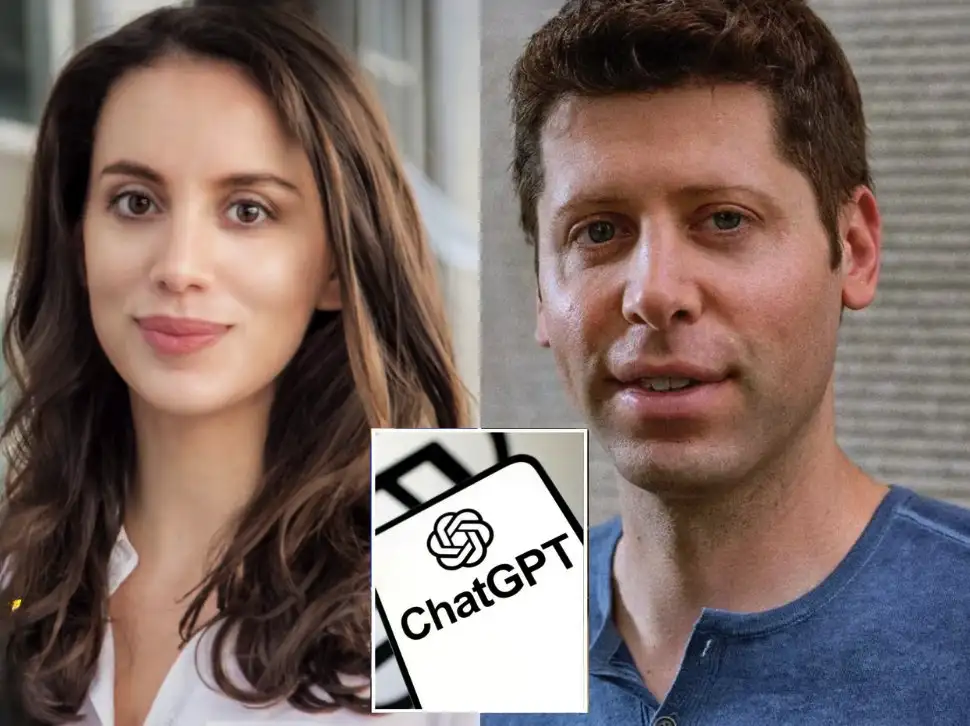The Woman Behind OpenAI's $300 Billion Growth
.webp)
Eric Walker · 16, July 2025
While everyone praises Sam Altman, there's an untold story about the real genius who transformed OpenAI from a research lab into a global AI powerhouse. Meet Mira Murati, the former Chief Technology Officer who didn't just build technology — she built a revolution that changed how humanity interacts with artificial intelligence.

The Architect Nobody Talks About
Born in Albania and educated at Dartmouth and MIT, Mira Murati joined OpenAI in 2018 when it was still a relatively unknown nonprofit research lab. What happened next would reshape the technology landscape forever. As CTO from 2022 to 2024, she led the development of ChatGPT, DALL-E, and other groundbreaking AI systems that would captivate the world.
But here's what makes her story remarkable: while others focused on building more powerful AI models, Murati solved a problem nobody else could crack — making AI actually usable for everyday people. This wasn't just a technical achievement; it was a paradigm shift that would propel OpenAI to unprecedented heights.
The Impossible Challenge of 2020
When AI Was Stuck in Labs
In 2020, the tech industry faced a paradox. Companies like Google, Meta, and Microsoft had developed incredibly powerful AI models, but they remained academic curiosities. These systems were unpredictable, often producing harmful content, and impossible to deploy at scale. The gap between AI's potential and its practical application seemed insurmountable.
Traditional approaches weren't working. Tech giants poured billions into making larger models with more parameters, believing raw computational power would solve the usability problem. They were wrong. The models became more impressive in controlled demonstrations but remained too unreliable for real-world deployment.

Murati's Revolutionary Approach
Instead of following the industry's obsession with model size, Murati took a radically different path. She recognized that the problem wasn't the AI's capability — it was the interface between human intent and machine understanding. Her insight was simple yet profound: don't just build better AI; build better systems for humans to interact with AI.
She assembled a team focused on three critical areas: safety mechanisms that prevented harmful outputs, feedback loops that continuously improved responses, and user interfaces that made complex AI accessible to non-technical users. This holistic approach would prove to be OpenAI's secret weapon.
The Feedback Loop Revolution
Learning from Every Interaction
Murati's masterstroke was implementing a system where ChatGPT learned from millions of user interactions. Unlike traditional software that remained static after deployment, her team created an AI that evolved with use. Every conversation, every correction, every piece of feedback made the system smarter and safer.
This wasn't just about collecting data. Murati's team developed sophisticated algorithms to identify patterns in user satisfaction, detect potential safety issues before they escalated, and automatically adjust the model's behavior. They turned users into unwitting collaborators in building the world's most advanced conversational AI.
The Numbers That Shocked Silicon Valley
The results were staggering. OpenAI's valuation skyrocketed from under $1 billion in 2020 to over $150 billion by 2024. Annual revenue jumped from $3.5 million in 2020 to a projected $3.7 billion in 2024, with expectations to reach $12.7 billion by 2025. But the most impressive metric was user adoption: ChatGPT reached 100 million monthly active users in just two months after its November 2022 launch, making it the fastest-growing consumer application in history.
These weren't just vanity metrics. Each user represented validation of Murati's approach. While competitors struggled to move their AI from labs to products, OpenAI was processing millions of queries daily, each one making their system more robust and reliable.
Making AI Accessible to Everyone
The Grandmother Test
Murati often spoke about making AI so simple that anyone could use it, regardless of technical expertise. Her team obsessed over every detail of the user experience. They eliminated jargon, simplified interfaces, and built intuitive safeguards that prevented users from accidentally triggering problematic responses.
The result was revolutionary. ChatGPT didn't require users to understand machine learning or craft perfect prompts. It worked with natural language, understood context, and could gracefully handle ambiguous requests. For the first time, AI became as easy to use as a search engine but infinitely more powerful.
Free ChatGPT available on GlobalGPT, an all-in-one AI platform.
Rapid Iteration: The Hidden Innovation
While competitors spent years perfecting models before release, Murati pioneered a rapid deployment cycle. Her team pushed updates weekly, sometimes daily, based on real-world usage patterns. This wasn't recklessness — it was strategic brilliance. Each iteration incorporated lessons from millions of interactions, creating a compound effect that left competitors behind.
This approach required exceptional engineering. Murati's team built infrastructure that could deploy changes without disrupting service, monitor impacts in real-time, and roll back problematic updates within minutes. They turned OpenAI into a learning organization where the pace of improvement accelerated with scale.
The Enterprise Revolution
From Experiment to Essential
Under Murati's leadership, OpenAI transformed from an interesting experiment to an essential business tool. Fortune 500 companies integrated ChatGPT into customer service, content creation, and data analysis. Startups built entire products on OpenAI's APIs. The technology became infrastructure for a new economy.
But Murati understood that enterprise adoption required more than powerful technology. She prioritized reliability, built robust APIs that could handle massive scale, and created pricing models that made sense for businesses. Most importantly, she established trust by being transparent about the technology's limitations and continuously improving its capabilities.
The Microsoft Partnership
One of Murati's most strategic moves was deepening OpenAI's partnership with Microsoft. This wasn't just about funding — though Microsoft's multi-billion dollar investment certainly helped. It was about combining OpenAI's innovation with Microsoft's enterprise reach and cloud infrastructure. The partnership gave OpenAI instant credibility with corporate customers while providing the computational resources needed to scale globally.
Building Trust at Scale
Ethics as a Competitive Advantage
What truly set Murati apart was her commitment to responsible AI development. While others rushed to market with powerful but potentially dangerous systems, she insisted on building safety into every layer of the product. This wasn't just ethical — it was strategic. By proactively addressing concerns about AI safety, OpenAI built trust with users, regulators, and partners.
Her team implemented multiple safety mechanisms: content filters that prevented harmful outputs, monitoring systems that detected misuse, and transparency initiatives that helped users understand how the AI made decisions. These weren't afterthoughts — they were core features that differentiated OpenAI from competitors who treated safety as a compliance checkbox.
The Trust Dividend
This focus on trust paid enormous dividends. While other AI companies faced backlash over biased or harmful outputs, OpenAI maintained a positive public image. Users felt safe experimenting with ChatGPT, knowing safeguards were in place. This trust translated directly into adoption — people recommended the product to friends, companies felt comfortable deploying it, and regulators viewed OpenAI as a responsible actor in the space.
The Legacy and Future
Departure and Impact
In September 2024, after six transformative years, Murati announced her departure from OpenAI to "create time and space" for personal exploration. Her exit marked the end of an era, but her impact remains indelible. The systems she built, the culture she established, and the standards she set continue to guide OpenAI's development.
Her legacy extends beyond OpenAI. Murati proved that successful AI deployment requires more than technical brilliance — it demands understanding human needs, building trust, and creating systems that improve with use. She showed that the most powerful technology is useless if people can't or won't use it.
Lessons for the Future
Murati's journey offers crucial lessons for technology leaders. First, solving the right problem matters more than building impressive technology. Second, user feedback is more valuable than laboratory perfection. Third, trust and safety aren't constraints on innovation — they're enablers of adoption. Finally, success requires bridging the gap between what's possible and what's practical.
As AI continues to reshape our world, Murati's approach provides a blueprint for responsible innovation. She demonstrated that the companies that win aren't necessarily those with the best technology — they're those that best understand and serve human needs while building systems worthy of trust.
The Complete Innovation
Mira Murati's story reminds us that true innovation requires more than technical breakthroughs. It demands understanding the human context in which technology operates. While others built powerful AI models, she built the bridge between artificial intelligence and human intelligence. That bridge — built on trust, accessibility, and continuous improvement — transformed OpenAI from a research project into one of the most valuable companies in history.
Her departure from OpenAI opens a new chapter, both for her and for the company she helped build. Whatever she pursues next will undoubtedly benefit from her unique ability to see beyond technology to its human impact. And OpenAI, now valued at over $150 billion with millions of users worldwide, stands as a testament to her vision: AI that's not just powerful, but purposeful; not just intelligent, but accessible; not just revolutionary, but responsible.
The lesson is clear: in the age of AI, success belongs not to those who build the most advanced technology, but to those who build technology that advances humanity.
